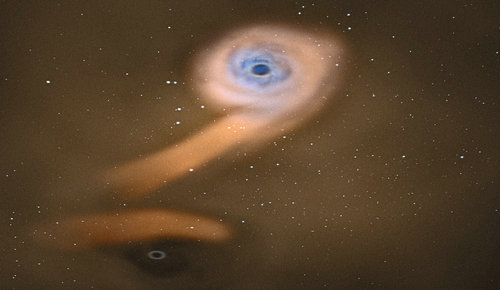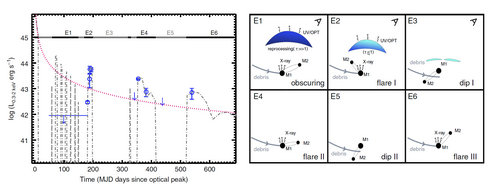Odd X-ray flares from a SMBH pair tearing star
Using data from NASA's Swift and ESA's XMM-Newton satellites, a team of Chinese researchers from Anhui Normal University, National Astronomical Observatories of CAS (NAOC), University of Science and Technology of China, Guangzhou University, Shanghai Astronomical Observatory of CAS, Sun Yat-Sen University, and Peking University found new evidence for the existence of two close supermassive black holes (SMBH) in the center of a normal galaxy. They were discovered because they ripped apart a star, producing flaring X-ray emission, and these X-rays were seen by Swift and XMM-Newton. It is the second stellar tidal disruption event by a candidate supermassive black hole binary known to date, strongly implying that such a phenomenon may not be as rare as we thought before. The discovery provides the smoking gun that galaxies grow through mergers, and most massive galaxies in the Universe harbour at least one supermassive black hole at their center. The research result was recently published on Nature Communications.

Fig.1: A cartoon of a pair of black holes, with the one on top accreting material from a dying star, while the one on bottom breaks the stream of debris. (Credit: ESA/C. Carreau)
On 2 Jan 2016, the Optical Gravitational Lensing Experiment (OGLE) detected a bright optical transient, called OGLE16aaa, coincident with the nucleus of a normal galaxy. Following the optical outburst, Swift observed it frequently but did not detect any X-rays for at least 140 days. Between days 141 and 153 since optical peak, the X-rays appeared and were caught by both Swift and XMM-Newton with a brightening in the flux by a factor of more than 60. Such a rapid X-ray flaring within only two weeks is unusual, which has been confirmed by an independent study led by Jari J.Kajava at Centro de Astrobiologia, Spain. But follow-up observations by Swift showed a remarkable thing: the X-ray flux from this event seems to disappear for some time after the start of the flare. Most surprisingly, about 150 days later, its X-rays reappeared. Then the X-rays fell below detectable levels and appeared again after another 150 days.

Fig.2: Left: X-ray light curve (blue data points) modeled with stellar tidal disruption by a supermassive black hole binary. Right: An artist's render of the supermassive black hole binary tearing and heating the debris of disrupted stellar materials. (Credit: Shu et.al)
“The overall X-ray evolution follows the t^-5/3 power-law if nothing had happened, well consistent with the expected fading rate from a tidal disruption event (TDE) caused by a SMBH,” said Xinwen Shu, the lead author of the paper from Anhui Normal University.
The puzzling drop-outs in the X-ray light curve had been sparsely seen after other TDEs. “The behavior is exactly the same as the galaxy SDSS J120136.02+330305.5, which can be best explained by a pair of supermassive black holes in the process of swallowing a star,” said Fukun Liu, co-author on the paper from Peking University, China.
The sudden drop-outs and then recoveries of X-rays are because the gravitational tug of one of the black holes disrupted the flow of gas onto the other, which could temporarily deprive it to fuel the X-ray emission. These two black holes should eventually spiral together and merge, as they move in their orbits. “The eventual merger may produce the strongest source of gravitational radiation in the Universe which could be the main target of next generation gravitational wave detectors such as LISA,” said Shuo Li, a researcher from NAOC and co-author of the paper.
If the interpretation of the TDE by a SMBH binary is correct, the X-ray non-detections in the early phase could be due to the obscuration by a dense column of gas, implying that the reprocessing may be a viable mechanism to account for the optical emission. “This is important to understand the difference between the TDE optical and X-ray emission”, said co-author Tinggui Wang, from University of Science and Technology of China.
The paper can be accessed at https://www.nature.com/articles/s41467-020-19675-z.